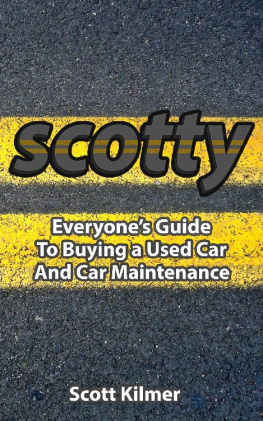Part One

Merge Fiat with Chrysler
A 2012 Trillium study of vehicle advertising in Ontario found that approximately 73 percent of automobile advertisements placed by automobile manufacturers were not in the spirit of the Motor Vehicle Dealers Association where a consumer could understand the final cost of a vehicle in a clear, comprehensive and prominent manner. In other words, if a dealer would have placed similar ads, we are confident the dealer would be in violation of the MVDAs advertising regulations.
Trillium Automobile Dealers Association (TADA) 2016, as submitted
to the Ontario Committee on Finance and Economic Affairs
Lemon-Aid supports TADAs conclusion that carmakers ads are deceptive. And, coming from Canadas largest provincial new car dealer association with a membership of over 1,000 dealers thats almost a third of all new car dealers in Canada governments mustnt ignore this accusation.
More Choice, Better Deals
Fueled by low crude-oil prices, rock-bottom interest rates and extended-term loans, consumers binged on new vehicles, making for record sales in 2015 in North America and 2016 looks like another banner year, too. At the same time, passenger-car sales have slumped as consumers embraced crossovers, SUVs and pickup trucks, encouraged by cheaper gas, improved fuel economy and the perceived utility of driving a multipurpose vehicle. Changing consumer tastes enabled Fiat Chrysler, Ford and General Motors to make windfall profits by pushing fully-loaded, technology-laden trucks and sport utilities.
During the past two years, oil prices have fallen precipitously from over $110 USD per barrel to $45 for some grades of crude. Although motorists welcome the savings at the pump, lower gas prices arent entirely good for the auto industry or the environment. Shoppers have been turning away from greener mini-compacts, diesels, hybrid and electric vehicles with the exception of the $100,000 Tesla Model S.
The trend has prompted Fiat Chrysler Automobiles to drop the slow selling (and unreliable) Dodge Dart and the Chrysler 200, while General Motors will retire the Buick Verano (a Chevrolet Cruze clone) for 2017. Slow sedan sales are particularly troublesome for GM. Sales of the redesigned Chevy Impala grew, but the model is expected to move from Oshawa to a Michigan plant.
Despite the sudden drop in the Canadian dollar against the U.S. currency, carmakers have managed to mostly hold the line on price increases of new vehicles. To move the iron dealers are sweetening rebates, adding standard equipment and offering new car loans for up to 96 months to shrink monthly payments, often at zero percent interest. Leasing is immensely popular again, especially when it comes to luxury brands. There have been some price increases, of course, that the industry has camouflaged by increasing Transport and Preparation fees, reducing dealer margins, and promoting bargain-priced models in their advertising which you will have trouble finding stocked at dealerships.
On the used-car side, Canadas weakening loonie has resulted in a robust export market to the United States for used luxury vehicles, pickups and SUVs, and driven up prices for used vehicles. Agents acting on behalf of U.S. dealers are buying up late-model used vehicle inventories from Canadian dealers, leaving consumers to sift through the remainders. According to auto industry analyst Dennis DesRosiers, some 200,000 used cars and trucks were plucked from the Canadian market in 2015 and shipped to waiting customers in the U.S. The trend continues in earnest in 2016.
Here Today, Gone Tomorrow
For 2017 it will take a sharp eye to spot which of the new and upgraded models are worth more money than last years offerings.
2017 Models: New, Dropped
New or Significantly Changed Models for 2017
Audi A4
Audi A5
Audi Q7
Buick LaCrosse
Buick Encore
Buick Envision
Cadillac CT6
Cadillac XT5
Chevrolet Bolt
Chevrolet Cruze Hatchback
Chevrolet Malibu Hybrid
Chevrolet Sonic
Chevrolet Trax
Chrysler Pacifica
Fiat 124 Spider
Ford Escape
Ford Fusion
Genesis G90
GMC Acadia
Honda Civic Hatchback
Honda Ridgeline
Hyundai Elantra
Hyundai Genesis G90
Hyundai Ioniq
Infiniti Q60
Infiniti QX30
Jaguar F-Pace
Jaguar XE
Jeep Wrangler
Kia Niro Hybrid
Kia Cadenza
Kia Optima HEV
Kia Sportage
Lincoln Continental
Mazda CX-9
Mazda MX-5 RF
Mercedes-Benz GLC Coupe
Mercedes-Benz E-Class
Mini Clubman
Mitsubishi Mirage Sedan
Nissan Armada
Porsche Boxster
Subaru Forester
Subaru Impreza
Toyota C-HR
Toyota Corolla
Volkswagen Golf Alltrack
Volvo S90
Dropped
Buick Verano
Chrysler 200
Chrysler Town & Country
Dodge Dart
Honda CR-Z
Toyota Venza
Buying Tips
Its good to be a patient shopper.
Time works to your advantage as better products make their debut and low oil prices continue to impact prices of fuel-sipping economy cars, compacts, hybrids and electrics. Shoppers may look forward to discounts of 5-10 percent, beginning with the holiday promotions at the end of the calendar year. Thats because many more Canadians are rushing to dealers to acquire expensive, less efficient, all-dressed large trucks, SUVs and European luxury vehicles during the autumn new model season. After being nagged for years about oil shortages and gas that would reach $7 a gallon, we have found ourselves awash in cheap oil and greater competition in the oil patch. Our collective consciousness says, Its time for a treat. I want mine. Bigger is better.
In addition to fuel savings from low oil prices, there are a number of other ways car buyers can save from $5,000 to $15,000 on a vehicle purchase.
- Buy a vehicle that is relatively uncomplicated, easy to service and has been sold in large numbers over many years. This will ensure that cheaper, independent repair shops can provide service and there is a good supply of less expensive aftermarket parts.
- Begin your vehicle research anytime, but wait until the depth of winter, if you can, to negotiate a more reasonable price. Car shopping between December and February can yield savings; the new-model-introduction hoopla has died down, holiday incentives are on and dealers are hungrier when frigid weather keeps buyers at home. Seasonal prices vary even more for used vehicles, with winter offering the best deals.
- For maxium savings on a new vehicle, look for a model thats finishing its model run during the summer, or the previous generation of a used vehicle before the most recent redesign.
- Dont buy European offerings, unless you know local servicing that is competent and reasonably priced. Dealership networks are notoriously weak for these cars after the warranty is over, parts can be inordinately expensive and hard to find, and few independent garages will invest in the expensive equipment needed to service complicated emissions and fuel-delivery systems. CBC aired a story of an Ontario woman who bought a used 2010 Mini (made by BMW) and after seven months was given an estimate for a $10,000 engine rebuild. The old axiom that there is a right way, a wrong way and an expensive European way to fix a car still holds true for most models from the European luxury carmakers.
- Think twice before you buy a hybrid or electric vehicle. Most give a poor return on expenditure, are complicated to service and dealer-dependent. Many hybrids dont provide the fuel economy or savings they hype. The exceptions are Toyota models like the Prius and hybrid Camry with the Hybrid Synergy Drive system. These are durable hybrids (400,000 km and more in taxi service) that deliver fuel savings of 30 percent compared to similar conventional vehicles. Contrary to perceptions, recent VW diesels are much less reliable than most gasoline vehicles and theyre expensive to repair.








